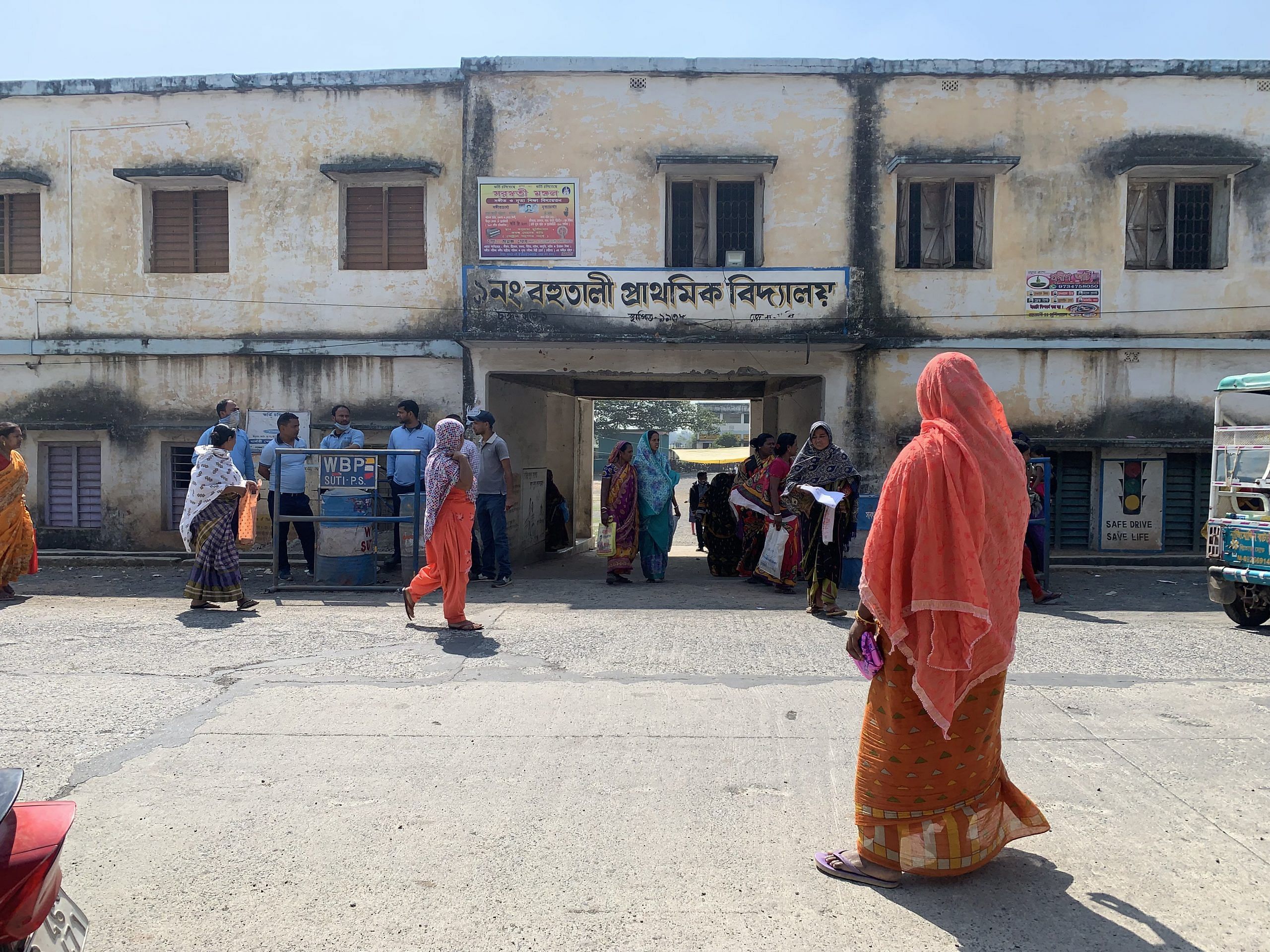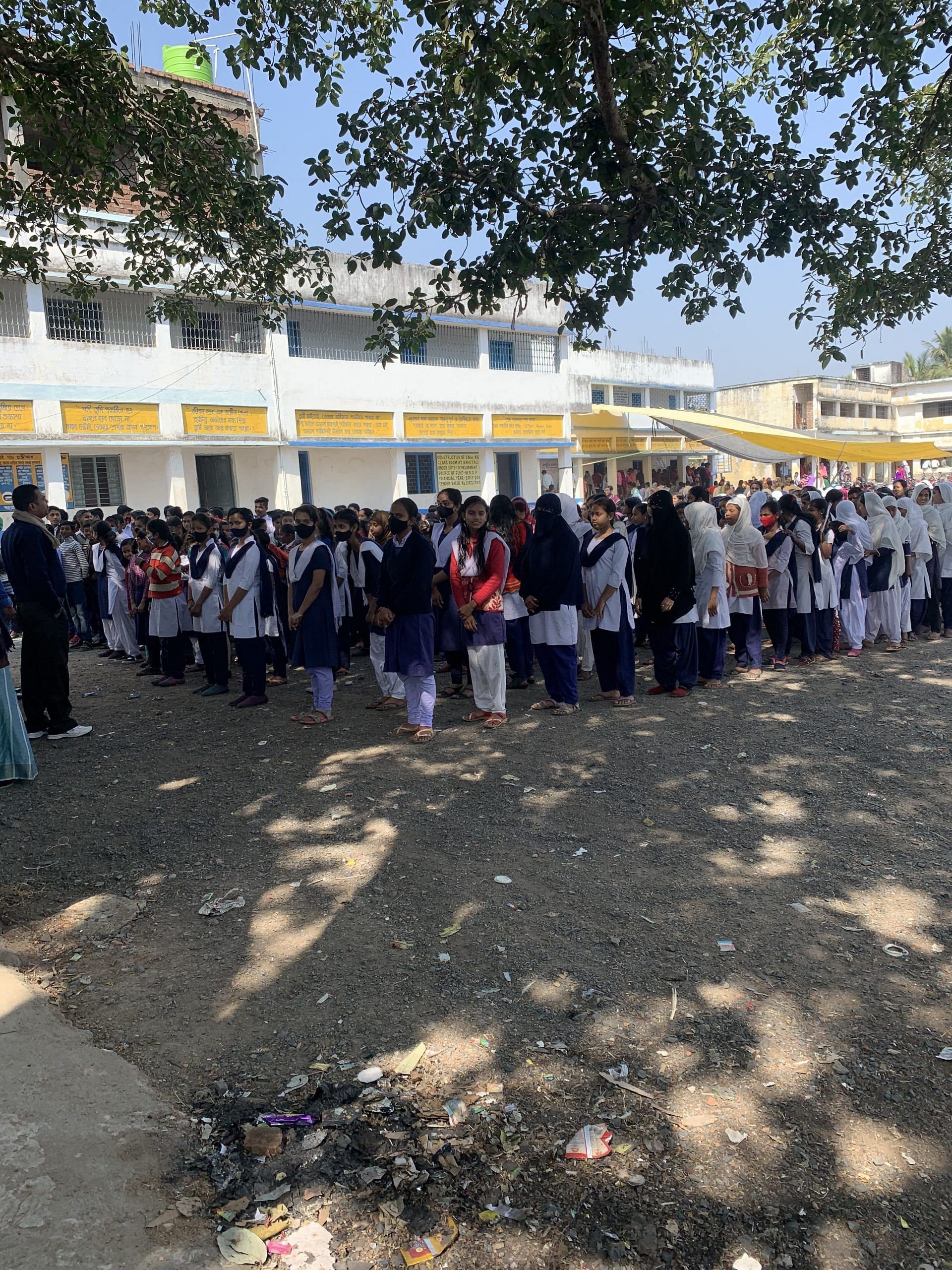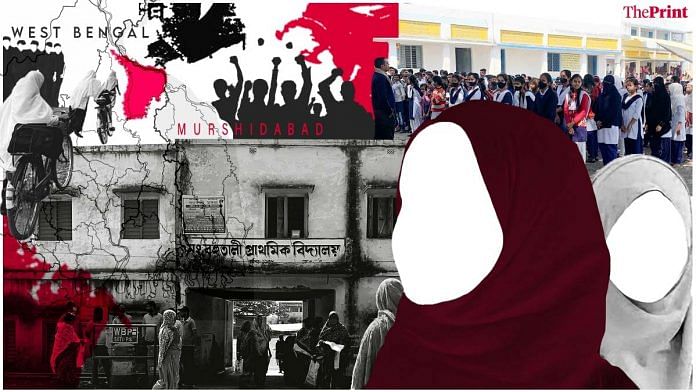Murshidabad: Thin, fraught, a veil of normality rests nervously over a school in a remote Bengal village. Barricades flank the entryway, with civic volunteers standing alert behind them, and a police picket keeps watch within.
Teachers pack the staffroom and students pour into the premises, as if it’s just another day of classes — but the classroom doors still bear the marks of stone pelting. Days after a sudden outburst of violence over a purported ban on pupils wearing the hijab, Bahutali High School is still reeling from the shock.
The school, in Muslim-majority Murshidabad district, is the only one in West Bengal to have witnessed such an attack as the row over the headscarf boils over in faraway Karnataka. Visuals of the violence on 12 February have gone viral, showing a mob storming and vandalising the campus while staff and students were reportedly holed up inside.
People from the neighbouring district of Birbhum also joined locals in the mob, say police. 18 people have been arrested thus far.
Several media outlets have claimed that the headmaster of the government-run school had banned the wearing of the hijab, triggering the conflagration. However, according to an assistant teacher at the school, the headmaster had only asked students not to wear black headscarves and stick to the uniform colours of blue and white.
Political polarisation has ensued over the incident, with Popular Front of India (PFI) and Bharatiya Janata Party (BJP) leaders both commenting on the events
ThePrint travelled to Murshidabad for an on-ground account of events.

Also read: The politics behind Karnataka’s hijab row: Sliding Congress, rising SDPI, combative BJP
An eyewitness account
Speaking to ThePrint, an assistant teacher, Mondal, narrates his eyewitness account of what took place.
“On Friday (11 February), the headmaster, after the morning prayers, told the students they couldn’t wear black headscarves. Since the uniform colour is blue and white, the students were asked to stick to those colours. The students listened but none raised any objections,” he says.
Adding that the headmaster was “always respected” by students and locals, Mondal says, “He never discussed this with the teachers — it was in the uniform guidelines.”
“The next day — around 11 am, when classes were going on — an angry mob barged into the school, asking for the headmaster over the hijab. In no time, the crowd swelled. The local police rushed in and tried to contain the situation. We also tried speaking to them, but they were very agitated,” he adds.
“As the headmaster stepped out to speak and apologise, the mob targeted him and started throwing stones and bricks,” he says, pointing to the “irony” of the fact that the headmaster himself had sanctioned those bricks and stones for a pathway at the school.
The police then resorted to lathi charges and fired tear gas shells as the crowd grew violent, says Mondal, adding that — contrary to some claims — there were no crude bombs hurled. The CCTV monitor that had recorded footage of the violence was, however, broken.
Recalling how stones were hurled at the first floor, he says, “From almost noon till 5 pm, we were all holed up in the classrooms, trying to protect the children. When the violence broke out, we were teaching. It was only at around 5 in the evening, when things settled down a bit, that we first evacuated the students, and then the police escorted us outside.”
“We have never seen such ugly clashes in this area before, leave alone this school. We were extremely frightened — we still are — but things are getting back to normal,” he adds.
Mondal has known the headmaster, Dinabandhu Mukherjee, since 2013. Mukherjee was an assistant teacher before passing the headmaster exam and selecting Bahutali High School.
In his nine years of service, Mondal says, Mukherjee was always looking at ways to make the school a better place. He initiated several developmental projects, including a mid-day meal room, a computer lab, and a better library. He got gates and boundary walls sanctioned for the school, and the latest initiative was to lay concrete on a pathway that’s currently uneven and muddy.
Mukherjee was transferred away from the Murshidabad school after the violence, and is now deputed in adjoining Nadia district.
Also read: Viral photos, bruised egos, radical student groups: Inside story of Karnataka’s hijab crisis
‘People from Birbhum joined the angry mob’
Riajul Haque, the block development officer of Suti 1, in which the school is located, says he was at the school from 11 am on the day of the attack. Also present were the local MLA and several police officers, including IPS officers, the officer in charge (OC), and the sub-divisional police officer. The mob vandalised Haque’s vehicle, as well as a police vehicle, he says.
Haque, too, says it was the headmaster’s official request to the students not to wear black scarves that had provoked the locals.
“The crowd started pelting stones at the headmaster, which is when the police had to lob tear gas, ” he says, adding, “Till about 2 pm, the crowd was comprised of locals, but after that, people from Birbhum district joined the agitation. I have submitted a report over the incident to the administration.”

18 people have been arrested and booked for unlawful assembly and rioting under Section 147 of the Indian Penal Code, says Suti police sub inspector Biplab Karmakar; he does not reveal their identities.
ThePrint also sent text messages to the superintendent of police, Jangipur, the Murshidabad district magistrate and West Bengal education minister Bratya Basu to seek further details of the incident and actions taken in the aftermath, but no responses had been received by the time this article was published.
Political dimensions, sensitive district
The violence at the Murshidabad school played right into the narrative of political polarisation.
West Bengal BJP co-in charge Amit Malviya took to Twitter and claimed crude bombs were hurled at the site. He wrote, “This is West Bengal, where rule of the mob prevails while Mamata Banerjee’s administration looks on, indulgently. The occasion could be anything, from polls to random protest. Hurling bombs is commonplace and there is just no control. Bengal is a tinderbox waiting to explode.”
Meanwhile, the Islamic organisation Popular Front of India (PFI) was gearing up for its big Bengal meet on 17 February. Its chosen site was in the same district, just an hour from the school. Murshidabad, which borders the West Bengal districts of Birbhum, Malda and Nadia, as well as Bangladesh and Jharkhand, has a 66.27 per cent Muslim population according to the 2011 census, the highest such proportion in the state.
The district’s Lalgola area was the site of massive protests against the Citizenship (Amendment) Act in December 2019, where empty trains were set ablaze by angry locals.
In September 2020, the National Investigation Agency, in a joint operation with the Border Security Force, arrested 11 suspected Al-Qaeda terrorists from Murshidabad district.
PFI general secretary for West Bengal Obaidullah Nuri issued a video statement on the PFI Bengal Facebook page in which he said, “The headmaster of Bahutali High School had threatened a student with rustication if she wore a burqa.” Accurate or not, such statements served to fan sentiments when the issue was taken up again at the 17 February meeting, which close to 2,000 locals attended.
Bahutali High School — site of the attack
Bahutali High School was established in 1938 and is managed by the state education department. It’s a Bengali-medium, co-educational institute covering classes 5 to 12, with approximately 3,000 students from the neighbourhood of Suti under Jangipur police district in Murshidabad. The majority of the students belong to the Muslim community, say teachers. The uniform is a blue-and-white one prescribed by the education department.
As ThePrint observes, students rush into files, standing at arm’s length from each other; it’s the national anthem that they chant as their morning prayer. They’re happy to be back at school after nearly two years, and are still a little confused as to where they should sit. And, for now, they’ve put the violence behind them.
(Edited by Rohan Manoj)
Also read: ‘We don’t support fanatics’ — RSS Muslim wing disowns member’s defence of ‘purdah’ amid hijab row



